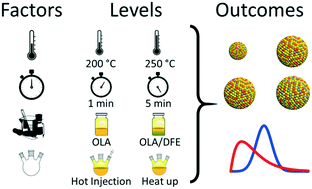Design of experiments a powerful tool to improve the selectivity of copper antimony sulfide nanoparticles synthesis†
Abstract
Several copper chalcogenide nanoparticles have been investigated as attractive candidates for replacing toxic (lead and cadmium based) and expensive (indium based) semiconductors. Among these materials, copper antimony sulfides present promising physical properties and reduced costs. Despite many works have dealt with the synthesis of these materials, fewer advanced on the formation mechanisms of the nanoparticles. Herein, we use the design of experiments as a tool to identify the role of each synthesis parameter on the composition, particle size, and optical properties of the obtained material. We evaluated synthesis time and temperature, solvent mixture, and two methods: heat up and hot injection. The nanoparticles were characterized by transmission electron microscopy, Raman spectroscopy, X-ray diffraction, UV-vis-NIR absorption spectroscopy and photoluminescence spectroscopy. The reaction time and synthesis method were found as the main factors governing phase compositions and nanoparticle size.

- This article is part of the themed collection: Crystal Growth


 Please wait while we load your content...
Please wait while we load your content...